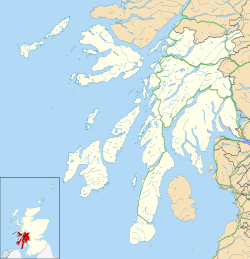
Summary
56°32′31″N 6°48′49″W / 56.542061°N 6.813492°W
 Interior of Dun Mor | |
 Shown within Argyll and Bute | |
| Alternative name | Dùn Mòr |
|---|---|
| Location | Tiree |
| Coordinates | 56°32′31″N 6°48′49″W / 56.542061°N 6.813492°W |
| Type | Broch |
| History | |
| Periods | Iron Age |
Dun Mor Vaul (or simply Dun Mor; Scottish Gaelic: Dùn Mòr) is an iron-age broch located on the north coast of the island of Tiree, in Scotland.
Description edit
Dun Mor (grid reference NM04234927) is situated on a rocky knoll on the northern coast of island of Tiree, about 1 kilometre northwest of the hamlet of Vaul. The broch consists of a drystone tower with an internal diameter of 9.2 metres with walls about 4.5 metres thick.[1] The outer face of the wall survives to a maximum height of 2.2 metres.[2] The entrance is on the southeast side.[1] On the north side of the entrance passage is a small side-chamber, of a type usually called a "guard cell".[1] The intramural cavity is well-preserved, and there are the remains of a staircase, which led to the upper levels, on the north side.[1]
The broch was additionally protected by two outer lines of defence, one drawn round the irregular margin of the summit on all sides, and the other taking the form of a hornwork which restricted access from the landward side of the knoll.[2]
Excavations edit
The broch was partly excavated around 1880, and it was almost completely excavated by E. W. MacKie in 1962–4.[2]
The excavations showed that there had been two phases of occupation before the broch was built.[2] In the earliest phase (5th century BC) there appears to have been a wooden hut, which may have been destroyed by fire.[2] This was followed by a more extensive settlement occupying a larger proportion of the summit area.[2] After an interval of unknown duration (possibly several centuries) the knoll was reoccupied and the construction of the broch and its outworks began.[2]
The construction of the broch was dated by radiocarbon dating to the 1st century AD.[2] It appears to have been used initially as a communal refuge, but by the 2nd century it had become instead the permanent residence of a single family.[2] Before long the upper storeys of the broch wall were demolished, and a round house (or an aisled wheel-house) was constructed within the interior.[2] It seems the broch was abandoned in the mid 3rd-century, the latest datable artefact from the interior being a fragment of a Roman glass bowl made in the Rhineland between 160 and 250 AD.[2]
The finds include large quantities of native pottery sherds; fragments of Roman glass and samian-ware and coarse-ware vessels; bronze and silver spiral finger-rings; rotary querns; quartzite strike-lights; glass ring-beads; tools and dice of bone; and several tools used in weaving and the working of metals.[2] The finds are now in the Hunterian Museum, University of Glasgow.[3]
References edit
- ^ a b c d Ritchie, J N G (1998). Brochs of Scotland. Shire Publications. pp. 35–7. ISBN 0747803897.
- ^ a b c d e f g h i j k l Historic Environment Scotland. "Tiree, Dun Mor, Vaul (21524)". Canmore. Retrieved 15 February 2014.
- ^ Ritchie, J N G (1998). Brochs of Scotland. Shire Publications. p. 45. ISBN 0747803897.
Further reading edit
External links edit
Media related to Dun Mor Vaul at Wikimedia Commons


